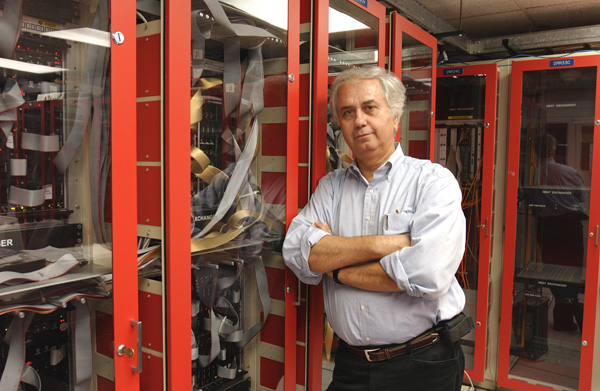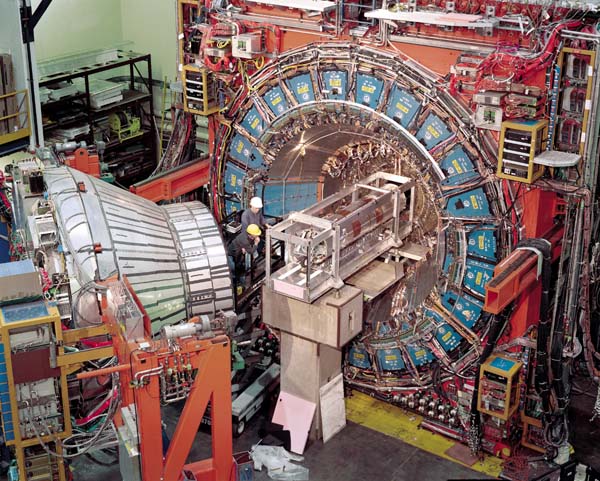 |
|
Making an Impact by Pamela Zerbinos
In the late 1980s, Luciano Ristori had an idea.
Researchers had just gotten their hands on a new technology that allowed
them to design and build their own silicon microchips. The technology, called
VLSI for Very Large Scale Integration, had previously been available only
to large companies like Intel and Motorola, but gradually it leaked into the
research sector and allowed scientists and engineers to design and build
integrated circuits for very specific purposes.
Ristori, a CDF collaborator from the Italian Institute of Nuclear Physics (INFN)
laboratory at Pisa, convinced himself that chips could be built for the specific
purpose of matching up patterns created by particles flying through the layers
of a silicon detector — which did not yet exist. The silicon detector is now the
innermost layer in a series that makes up a large detector like CDF or DZero,
and is therefore the first to “see” the products of a particle collision.
The particles in question are the protons and antiprotons that Fermilab’s
Tevatron smashes together at very high energies to watch what comes out.
One kind of particle that sometimes comes out is the B meson, made of
a bottom quark and a lighter anti-quark. The B meson travels about one
millimeter (that’s a long way in particle physics) and then decays into
other particles called pions and kaons. As these particles pass through
the detector, they leave tracks that scientists can use to figure out exactly
what kind of particle it was.
Decays, collisions and other events happen at the Tevatron at a rate of
millions per second, and even Fermilab doesn’t have enough disk space
to save them all. So they have to filter out the important events and throw
everything else away. This is accomplished by a set of electronic devices
collectively known as “the trigger” that measure all kinds of factors — speed,
energy, charge, etc. The trigger has to make extremely fast decisions about
which events to keep and which ones to throw away.
“This is important,” Ristori said,“because there is no going back. Once
you reject an event, it is lost forever.” CDF is currently keeping an average
of 50 events per second,“so we’d better make sure they’re the right 50.”
And that’s where his idea came in. He thought it would be possible to use
VLSI to design circuits that would match new particle tracks with previously
identified geometric patterns to find out how long the particle had traveled
before decaying — all in about 20 microseconds. This information could
then be used in the trigger to keep valuable B meson events from being
thrown out.
“In the early days,” said CDF cospokesman Nigel
Lockyer, “nobody believed it would work. It was too
ambitious, and we didn’t understand whether the
beam was stable. We didn’t know whether you
could find these tracks fast enough. We hadn’t even
put silicon detectors in the experiment at that point.
None of the technology was available to do this.”
But Ristori went ahead with it anyway, and the
project, called the Silicon Vertex Tracker (SVT),
was proposed to CDF in 1991.
“I was convinced that it was a good thing to do,
that it would be important, and I was convinced that
we could do it,” he said.“There was no reason why
we couldn ’t do it. I did the first step, which was to
convince people that it was not totally crazy.”Once
he had convinced the first two or three people at
the University of Pisa, others quickly followed and
now the collaboration includes the University of
Chicago, the University of Geneva and the INFN
labs at Rome and Trieste.
“I think the real virtue of the people who started
working on this was to believe it could be done,”
said Ristori.“It took some courage — it was a new
technology and it was very easy to make mistakes.
There were many, many ways we could have
failed.”
Over the more than 10 years he’s been working
on the SVT, he’s had help from more than 20
people, several of whom worked full-time on the
device for several years. Ristori estimates the
total amount of work put into the project to be
around 50 man-years.
“There were a lot of good people who worked for
many years,” Ristori said.“It took a lot of ideas.
We had to solve many problems. It was much
harder than I anticipated, but we had enough
people who were good enough to solve all these
problems and go through to the end.”
Their work was funded in large part by INFN,
the U.S. National Science Foundation and the
Department of Energy. Ristori thinks the project
cost around $1 million, but the exchange rate has
fluctuated so much in the past 12 years that it’s
hard to keep track. More importantly,“they always
gave me the money I asked for.”
All the hard work has paid off; the SVT has been
up and running since Run II began in March 2001.
It’s the only device like it in the world, and it gives
CDF important — and sometimes unexpected —
capabilities.
“It’s given us the ability to do all kinds of things we
never thought we could do,” said Lockyer.“We now
have the world’s largest sample of charm [quarks].
We never planned on doing charm physics, but it
turns out that the charm lifetime is very similar to
the B lifetime, and all of a sudden we’re inundated
with all this charm. It’s very exciting for us.”
The 53-year-old Ristori was born in Prato, just
outside Florence. He has always been interested
in mathematics and physics, and attended the
University of Pisa, where he “had to make this
choice between physics and mathematics. I chose
physics, and I do not regret it. ”He received his
Laurea in Fiscia (Italy was not offering Ph.D.s at
the time) from Pisa in 1971 and soon joined the
NA1 experiment at CERN, the European Particle
Physics Laboratory, as an INFN-Pisa collaborator.
He stayed for several years, and then in 1980 he
visited Fermilab and decided to join CDF.
“I liked the place, I liked the physics, I liked
what they were planning to do at CDF and at the
Tevatron,” he said.“CERN was a very nice place,
but I like the style here, the way people are
working and interacting. I also like the lifestyle
here, this place, this part of the country.”
When he first joined CDF, he lived mostly in Pisa
and would commute back and forth several times
a year, staying a few weeks or a few months. Now
he and his wife live full-time in the Fermilab village,
and he visits Pisa several times a year.
“It’s important to keep the relationship with your
home institution, even if most of the work is here
at the moment,” he said.
His work here still involves the SVT,“but there
aren’t any major problems to solve. It needs to be
optimized, and there is fine tuning to do, but soon
we should be able to just turn it on and have it work.”
Once that happens, Ristori hopes to turn his attention
to some of the data produced by the device.
“I’d like to play a role at CDF in terms of looking at
the important physics results we can get with SVT,”
he said.“I think it’s the natural outcome of your
work — you’ve been working so many years to build
something, and then it works, and you want to see
the results in terms of physics. I’d like to play a
role in that, have more time to look at the outcome.
That’s the real motivation for going through all this
trouble. It’s fun, building something and using the
detectors. But in the end all of this would not be
worth it if it’s not useful for physics.”
|


